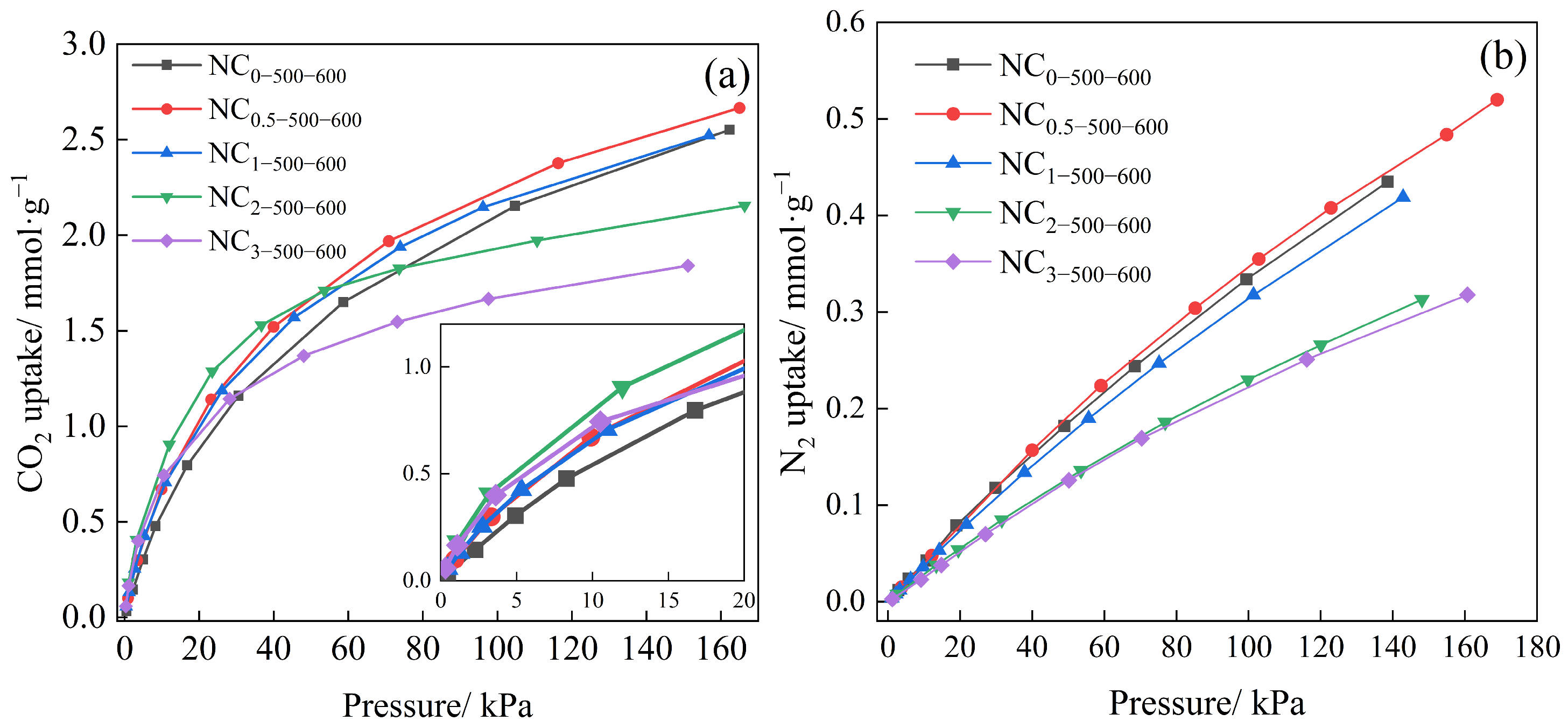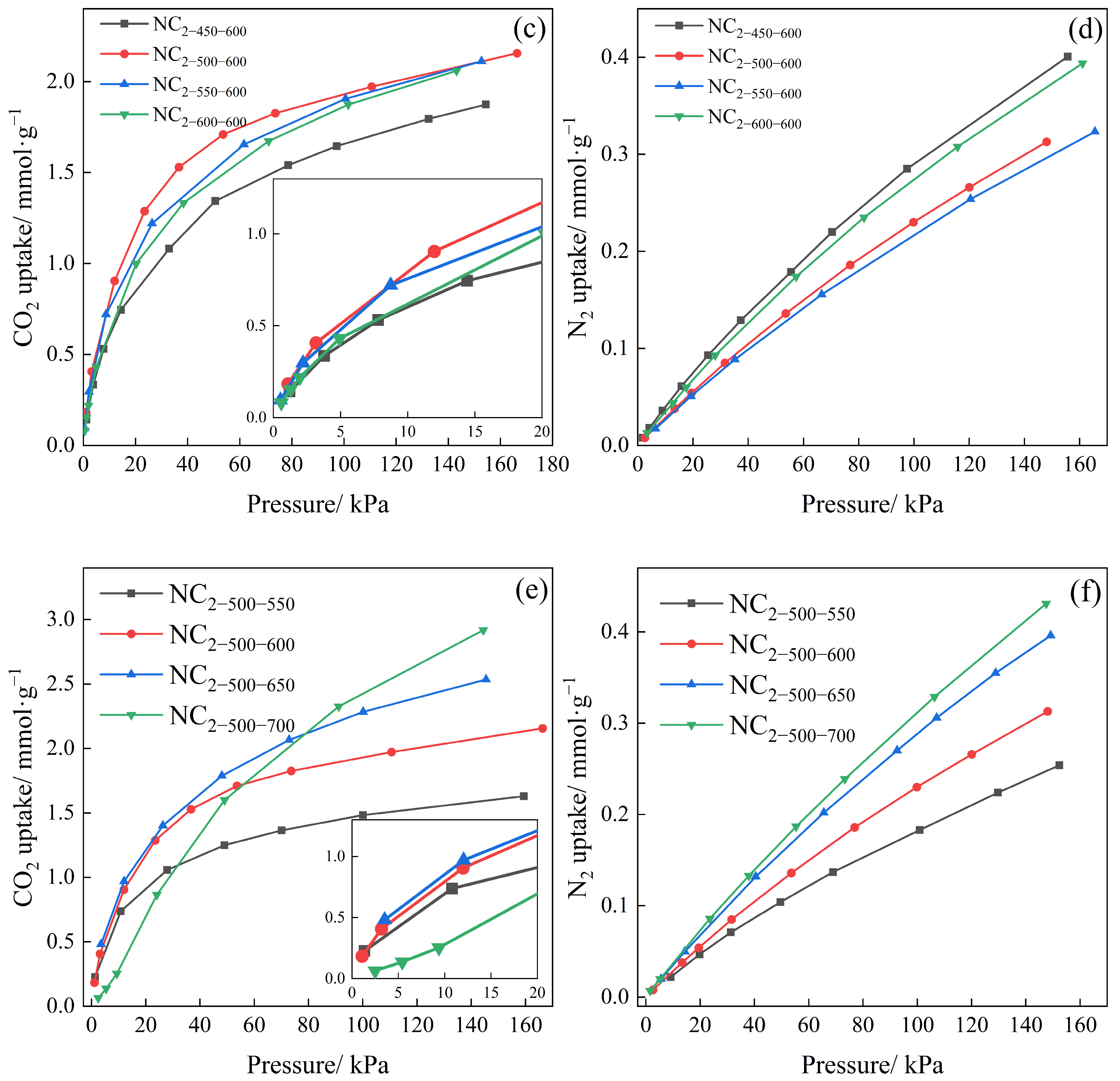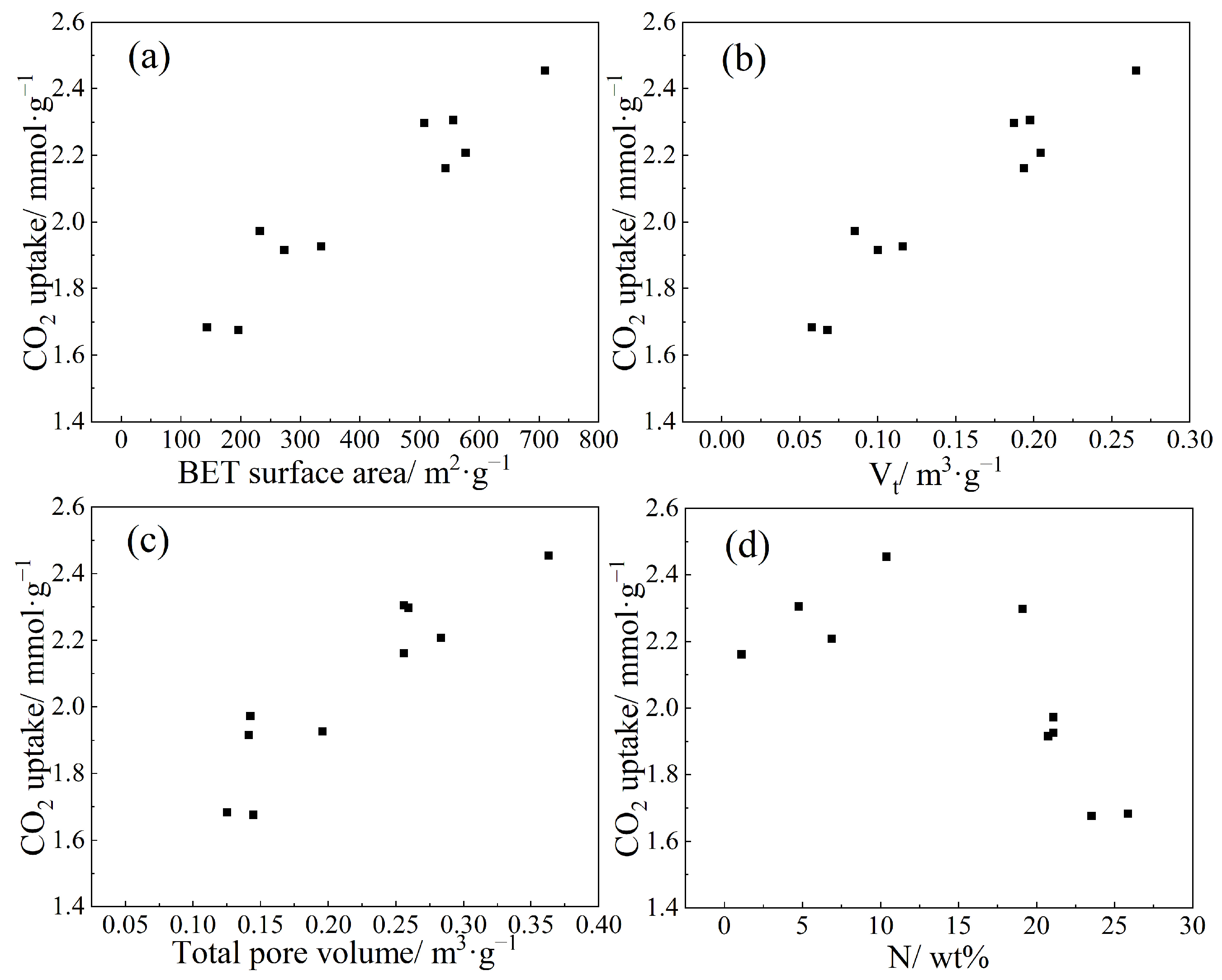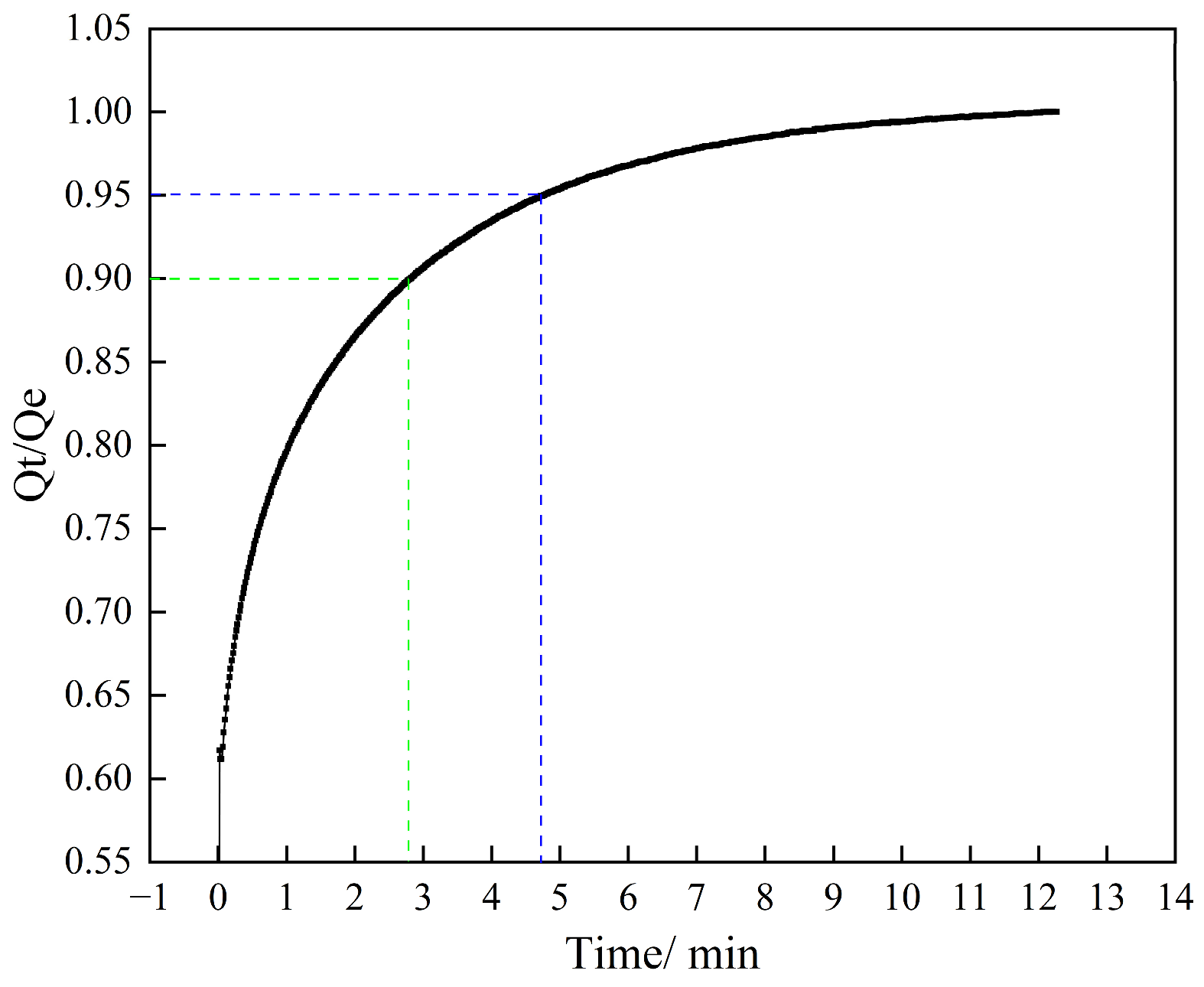Preparation and CO2 Adsorption Performance of Nitrogen-Doped Carbon Derived from Phenolic Resin
Abstract
1. Introduction
2. Materials and Methods
2.1. Preparation
2.1.1. Carbonization Under N2 Atmosphere
2.1.2. CO2 Activation
2.2. Adsorption Performance Evaluation
2.2.1. Static Volumetric Method
- Measurement of the Free Volume in the Adsorption Tank
- 2.
- Measurement of Adsorption Isotherms
2.2.2. Selectivity
3. Results and Discussion
3.1. Porosity Characterization
3.2. Elemental Composition and Surface Chemistry
3.3. Surface Morphology and Phase Analysis
3.4. Adsorption Performance
3.4.1. CO2 and N2 Adsorption Isotherms
3.4.2. CO2/N2 Selectivity
3.4.3. Cyclic Stability
3.4.4. CO2 Adsorption Kinetics
3.5. Comparison with Other Resin-Derived Carbons
4. Conclusions
- (1)
- An appropriate amount of nitrogen doping enhances CO2 adsorption performance, whereas excessive doping leads to pore structure deterioration and reduced adsorption capacity.
- (2)
- Carbonization temperature had a limited effect on pore development, and higher activation temperatures promoted more extensive porosity but also broadened the pore size distribution, reducing the proportion of narrow micropores and thus diminishing low-pressure adsorption capacity and separation selectivity.
- (3)
- The obtained materials were amorphous activated carbons with abundant micropores and high specific surface area. Nitrogen was primarily incorporated as pyridinic-N (N-6), and its content increased with the doping ratio but decreased at elevated carbonization and activation temperatures.
Supplementary Materials
Author Contributions
Funding
Data Availability Statement
Conflicts of Interest
References
- Chen, J.X.; Bao, A.; Siqin, D. N/S Dually Doped Nanoporous Carbon for CO2 Adsorption. ACS Appl. Nano Mater. 2024, 7, 12184–12193. [Google Scholar] [CrossRef]
- Ren, F.; Liu, W. Review of CO2 Adsorption Materials and Utilization Technology. Catalysts 2023, 13, 1176. [Google Scholar] [CrossRef]
- Boot-Handford, M.E.; Abanades, J.C.; Anthony, E.J.; Blunt, M.J.; Brandani, S.; Dowell, N.M.; Fernández, J.R.; Ferrari, M.-C.; Gross, R.; Hallett, J.P.; et al. Carbon Capture and Storage Update. Energy Environ. Sci. 2013, 7, 130–189. [Google Scholar] [CrossRef]
- Meng, F.; Meng, Y.; Ju, T.; Han, S.; Lin, L.; Jiang, J. Research Progress of Aqueous Amine Solution for CO2 Capture: A Review. Renew. Sustain. Energy Rev. 2022, 168, 112902. [Google Scholar] [CrossRef]
- Lashaki, M.J.; Khiavi, S.; Sayari, A. Stability of Amine-Functionalized CO2 Adsorbents: A Multifaceted Puzzle. Chem. Soc. Rev. 2019, 48, 3320–3405. [Google Scholar] [CrossRef]
- Plaza, M.G.; Pevida, C.; Arias, B.; Fermoso, J.; Casal, M.D.; Martín, C.F.; Rubiera, F.; Pis, J.J. Development of Low-Cost Biomass-Based Adsorbents for Postcombustion CO2 Capture. Fuel 2009, 88, 2442–2447. [Google Scholar] [CrossRef]
- Wu, T.; Wang, Z.; Wang, Y.; Ren, H.; Li, W.; Tang, Z.; Zhang, D. Investigations of Turbulence Influence on Pressure Swing Adsorption Process for CO2 Capture by Computational Mass Transfer. J. Environ. Chem. Eng. 2023, 11, 110485. [Google Scholar] [CrossRef]
- Younas, M.; Rezakazemi, M.; Daud, M.; Wazir, M.B.; Ahmad, S.; Ullah, N.; Inamuddin; Ramakrishna, S. Recent Progress and Remaining Challenges in Post-Combustion CO2 Capture Using Metal-Organic Frameworks (MOFs). Prog. Energy Combust. Sci. 2020, 80, 100849. [Google Scholar] [CrossRef]
- Wang, J.; Shen, Y.; Zhang, D.; Tang, Z.; Li, W. Integrated Vacuum Pressure Swing Adsorption and Rectisol Process for CO2 Capture from Underground Coal Gasification Syngas. Chin. J. Chem. Eng. 2023, 57, 265–279. [Google Scholar] [CrossRef]
- Pellegrini, L.A.; Moioli, S.; Gamba, S. Energy Saving in a CO2 Capture Plant by MEA Scrubbing. Chem. Eng. Res. Des. 2011, 89, 1676–1683. [Google Scholar] [CrossRef]
- Radosz, M.; Hu, X.; Krutkramelis, K.; Shen, Y. Flue-Gas Carbon Capture on Carbonaceous Sorbents: Toward a Low-Cost Multifunctional Carbon Filter for “Green” Energy Producers. Ind. Eng. Chem. Res. 2008, 47, 3783–3794. [Google Scholar] [CrossRef]
- Shafeeyan, M.S.; Daud, W.M.A.W.; Houshmand, A.; Shamiri, A. A Review on Surface Modification of Activated Carbon for Carbon Dioxide Adsorption. J. Anal. Appl. Pyrolysis 2010, 89, 143–151. [Google Scholar] [CrossRef]
- Sarwar, A.; Ali, M.; Khoja, A.H.; Nawar, A.; Waqas, A.; Liaquat, R.; Naqvi, S.R.; Asjid, M. Synthesis and Characterization of Biomass-Derived Surface-Modified Activated Carbon for Enhanced CO2 Adsorption. J. CO2 Util. 2021, 46, 101476. [Google Scholar] [CrossRef]
- Sneddon, G.; Greenaway, A.; Yiu, H.H.P. The Potential Applications of Nanoporous Materials for the Adsorption, Separation, and Catalytic Conversion of Carbon Dioxide. Adv. Energy Mater. 2014, 4, 1301873. [Google Scholar] [CrossRef]
- Ramdin, M.; de Loos, T.W.; Vlugt, T.J.H. State-of-the-Art of CO2 Capture with Ionic Liquids. Ind. Eng. Chem. Res. 2012, 51, 8149–8177. [Google Scholar] [CrossRef]
- Rashidi, N.A.; Yusup, S. An Overview of Activated Carbons Utilization for the Post-Combustion Carbon Dioxide Capture. J. CO2 Util. 2016, 13, 1–16. [Google Scholar] [CrossRef]
- Hasib-ur-Rahman, M.; Siaj, M.; Larachi, F. CO2 Capture in Alkanolamine/Room-Temperature Ionic Liquid Emulsions: A Viable Approach with Carbamate Crystallization and Curbed Corrosion Behavior. Int. J. Greenh. Gas Control 2012, 6, 246–252. [Google Scholar] [CrossRef]
- Aaron, D.; Tsouris, C. Separation of CO2 from Flue Gas: A Review. Sep. Sci. Technol. 2005, 40, 321–348. [Google Scholar] [CrossRef]
- Wang, S.; Li, X.; Wu, H.; Tian, Z.; Xin, Q.; He, G.; Peng, D.; Chen, S.; Yin, Y.; Jiang, Z.; et al. Advances in High Permeability Polymer-Based Membrane Materials for CO2 Separations. Energy Environ. Sci. 2016, 9, 1863–1890. [Google Scholar] [CrossRef]
- Khalilpour, R.; Mumford, K.; Zhai, H.; Abbas, A.; Stevens, G.; Rubin, E.S. Membrane-Based Carbon Capture from Flue Gas: A Review. J. Clean. Prod. 2015, 103, 286–300. [Google Scholar] [CrossRef]
- Yu, C.-H.; Huang, C.-H.; Tan, C.-S. A Review of CO2 Capture by Absorption and Adsorption. Aerosol Air Qual. Res. 2012, 12, 745–769. [Google Scholar] [CrossRef]
- Hou, R.; Fong, C.; Freeman, B.D.; Hill, M.R.; Xie, Z. Current Status and Advances in Membrane Technology for Carbon Capture. Sep. Purif. Technol. 2022, 300, 121863. [Google Scholar] [CrossRef]
- Luis, P.; Van Gerven, T.; Van der Bruggen, B. Recent Developments in Membrane-Based Technologies for CO2 Capture. Prog. Energy Combust. Sci. 2012, 38, 419–448. [Google Scholar] [CrossRef]
- Scholes, C.A. Challenges for CO2 Capture by Membranes. In Advances in Carbon Capture; Rahimpour, M.R., Farsi, M., Makarem, M.A., Eds.; Woodhead Publishing: Cambridge, UK, 2020; pp. 357–377. ISBN 978-0-12-819657-1. [Google Scholar]
- Siagian, U.W.R.; Raksajati, A.; Himma, N.F.; Khoiruddin, K.; Wenten, I.G. Membrane-Based Carbon Capture Technologies: Membrane Gas Separation vs. Membrane Contactor. J. Nat. Gas Sci. Eng. 2019, 67, 172–195. [Google Scholar] [CrossRef]
- Ben-Mansour, R.; Habib, M.A.; Bamidele, O.E.; Basha, M.; Qasem, N.A.A.; Peedikakkal, A.; Laoui, T.; Ali, M. Carbon Capture by Physical Adsorption: Materials, Experimental Investigations and Numerical Modeling and Simulations—A Review. Appl. Energy 2016, 161, 225–255. [Google Scholar] [CrossRef]
- Su, Y.; Liu, S.; Gao, X. Impact of Impure Gas on CO2 Capture from Flue Gas Using Carbon Nanotubes: A Molecular Simulation Study. Molecules 2022, 27, 1627. [Google Scholar] [CrossRef]
- Jiang, L.; Liu, W.; Wang, R.Q.; Gonzalez-Diaz, A.; Rojas-Michaga, M.F.; Michailos, S.; Pourkashanian, M.; Zhang, X.J.; Font-Palma, C. Sorption Direct Air Capture with CO2 Utilization. Prog. Energy Combust. Sci. 2023, 95, 101069. [Google Scholar] [CrossRef]
- Chen, S.; Wu, W.; Niu, Z.; Kong, D.; Li, W.; Tang, Z.; Zhang, D. High Adsorption Selectivity of Activated Carbon and Carbon Molecular Sieve Boosting CO2/N2 and CH4/N2 Separation. Chin. J. Chem. Eng. 2024, 67, 282–297. [Google Scholar] [CrossRef]
- Sattari, A.; Ramazani, A.; Aghahosseini, H.; Aroua, M.K. The Application of Polymer Containing Materials in CO2 Capturing via Absorption and Adsorption Methods. J. CO2 Util. 2021, 48, 101526. [Google Scholar] [CrossRef]
- Ding, M.; Flaig, R.W.; Jiang, H.-L.; Yaghi, O.M. Carbon Capture and Conversion Using Metal–Organic Frameworks and MOF-Based Materials. Chem. Soc. Rev. 2019, 48, 2783–2828. [Google Scholar] [CrossRef]
- Varghese, A.M.; Karanikolos, G.N. CO2 Capture Adsorbents Functionalized by Amine—Bearing Polymers: A Review. Int. J. Greenh. Gas Control 2020, 96, 103005. [Google Scholar] [CrossRef]
- Singh, G.; Lakhi, K.S.; Sil, S.; Bhosale, S.V.; Kim, I.; Albahily, K.; Vinu, A. Biomass Derived Porous Carbon for CO2 Capture. Carbon 2019, 148, 164–186. [Google Scholar] [CrossRef]
- Mochizuki, Y.; Bud, J.; Byambajav, E.; Tsubouchi, N. Influence of Ammonia Treatment on the CO2 Adsorption of Activated Carbon. J. Environ. Chem. Eng. 2022, 10, 107273. [Google Scholar] [CrossRef]
- Wang, L.; Yang, R.T. Significantly Increased CO2 Adsorption Performance of Nanostructured Templated Carbon by Tuning Surface Area and Nitrogen Doping. J. Phys. Chem. C 2012, 116, 1099–1106. [Google Scholar] [CrossRef]
- Abid, M.; Martínez-Escandell, M.; Silvestre-Albero, J. NaOH-Modified Activated Carbon Materials for Hydrogen Sulfide Removal. C—J. Carbon Res. 2025, 11, 68. [Google Scholar] [CrossRef]
- Choma, J.; Jedynak, K.; Fahrenholz, W.; Ludwinowicz, J.; Jaroniec, M. Microporosity Development in Phenolic Resin-Based Mesoporous Carbons for Enhancing CO2 Adsorption at Ambient Conditions. Appl. Surf. Sci. 2014, 289, 592–600. [Google Scholar] [CrossRef]
- Siemak, J.; Wróbel, R.J.; Pęksiński, J.; Michalkiewicz, B. Investigation of CO2 Adsorption on Avocado Stone-Derived Activated Carbon Obtained through NaOH Treatment. Materials 2023, 16, 4390. [Google Scholar] [CrossRef]
- Song, C.; Ye, W.; Liu, Y.; Huang, H.; Zhang, H.; Lin, H.; Lu, R.; Zhang, S. Facile Preparation of Porous Carbon Derived from Industrial Biomass Waste as an Efficient CO2 Adsorbent. ACS Omega 2020, 5, 28255–28263. [Google Scholar] [CrossRef]
- Sanz-Pérez, E.S.; Murdock, C.R.; Didas, S.A.; Jones, C.W. Direct Capture of CO2 from Ambient Air. Chem. Rev. 2016, 116, 11840–11876. [Google Scholar] [CrossRef]
- Li, Y.; Liu, N.; Zhang, T.; Wang, B.; Wang, Y.; Wang, L.; Wei, J. Highly Microporous Nitrogen-Doped Carbons from Anthracite for Effective CO2 Capture and CO2/CH4 Separation. Energy 2020, 211, 118561. [Google Scholar] [CrossRef]
- Yue, L.; Xia, Q.; Wang, L.; Wang, L.; DaCosta, H.; Yang, J.; Hu, X. CO2 Adsorption at Nitrogen-Doped Carbons Prepared by K2CO3 Activation of Urea-Modified Coconut Shell. J. Colloid Interface Sci. 2018, 511, 259–267. [Google Scholar] [CrossRef]
- Liu, S.; Rao, L.; Yang, P.; Wang, X.; Wang, L.; Ma, R.; Yue, L.; Hu, X. Superior CO2 Uptake on Nitrogen Doped Carbonaceous Adsorbents from Commercial Phenolic Resin. J. Environ. Sci. 2020, 93, 109–116. [Google Scholar] [CrossRef]
- de Souza, L.K.C.; Wickramaratne, N.P.; Ello, A.S.; Costa, M.J.F.; da Costa, C.E.F.; Jaroniec, M. Enhancement of CO2 Adsorption on Phenolic Resin-Based Mesoporous Carbons by KOH Activation. Carbon 2013, 65, 334–340. [Google Scholar] [CrossRef]
- Spessato, L.; Duarte, V.A.; Fonseca, J.M.; Arroyo, P.A.; Almeida, V.C. Nitrogen-Doped Activated Carbons with High Performances for CO2 Adsorption. J. CO2 Util. 2022, 61, 102013. [Google Scholar] [CrossRef]
- Wang, Z.; Goyal, N.; Liu, L.; Tsang, D.C.W.; Shang, J.; Liu, W.; Li, G. N-Doped Porous Carbon Derived from Polypyrrole for CO2 Capture from Humid Flue Gases. Chem. Eng. J. 2020, 396, 125376. [Google Scholar] [CrossRef]
- Liu, Z.; Du, Z.; Song, H.; Wang, C.; Subhan, F.; Xing, W.; Yan, Z. The Fabrication of Porous N-Doped Carbon from Widely Available Urea Formaldehyde Resin for Carbon Dioxide Adsorption. J. Colloid Interface Sci. 2014, 416, 124–132. [Google Scholar] [CrossRef] [PubMed]
- Rao, L.; Liu, S.; Wang, L.; Ma, C.; Wu, J.; An, L.; Hu, X. N-Doped Porous Carbons from Low-Temperature and Single-Step Sodium Amide Activation of Carbonized Water Chestnut Shell with Excellent CO2 Capture Performance. Chem. Eng. J. 2019, 359, 428–435. [Google Scholar] [CrossRef]
- Dang, W.; Lin, Q.; Pan, H.; Zhang, D. Facile Preparation of N-Doped Porous Carbon and Its CO2 Gas Adsorption Performance. J. Mater. Sci. 2022, 57, 12438–12448. [Google Scholar] [CrossRef]
- Kim, C.; Talapaneni, S.N.; Dai, L. Porous Carbon Materials for CO2 Capture, Storage and Electrochemical Conversion. Mater. Rep. Energy 2023, 3, 100199. [Google Scholar] [CrossRef]
- Liu, S.; Li, Q.; Wang, L.; Ma, R.; Zou, J.; Huang, L.; Hu, X. Facile Single-Step Synthesis of Porous Carbons as Efficient CO2 Adsorbents. Energy Fuels 2019, 33, 11544–11551. [Google Scholar] [CrossRef]
- Yaumi, A.L.; Bakar, M.Z.A.; Hameed, B.H. Melamine-Nitrogenated Mesoporous Activated Carbon Derived from Rice Husk for Carbon Dioxide Adsorption in Fixed-Bed. Energy 2018, 155, 46–55. [Google Scholar] [CrossRef]
- Zhao, C.; Ge, L.; Li, X.; Zuo, M.; Xu, C.; Chen, S.; Li, Q.; Wang, Y.; Xu, C. Effects of the Carbonization Temperature and Intermediate Cooling Mode on the Properties of Coal-Based Activated Carbon. Energy 2023, 273, 127177. [Google Scholar] [CrossRef]
- Heidarinejad, Z.; Dehghani, M.H.; Heidari, M.; Javedan, G.; Sillanpää, M. Methods for Preparation and Activation of Activated Carbon: A Review. Environ. Chem. Lett. 2020, 18, 393–415. [Google Scholar] [CrossRef]
- Zhu, Y.; Gao, J.; Li, Y.; Sun, F.; Gao, J.; Wu, S.; Qin, Y. Preparation of Activated Carbons for SO2 Adsorption by CO2 and Steam Activation. J. Taiwan Inst. Chem. Eng. 2012, 43, 112–119. [Google Scholar] [CrossRef]
- Kruk, M.; Jaroniec, M. Gas Adsorption Characterization of Ordered Organic−Inorganic Nanocomposite Materials. Chem. Mater. 2001, 13, 3169–3183. [Google Scholar] [CrossRef]
- Tiwari, D.; Bhunia, H.; Bajpai, P.K. Synthesis of Nitrogen Enriched Porous Carbons from Urea Formaldehyde Resin and Their Carbon Dioxide Adsorption Capacity. J. CO2 Util. 2017, 21, 302–313. [Google Scholar] [CrossRef]
- Liu, S.; Ma, R.; Hu, X.; Wang, L.; Wang, X.; Radosz, M.; Fan, M. CO2 Adsorption on Hazelnut-Shell-Derived Nitrogen-Doped Porous Carbons Synthesized by Single-Step Sodium Amide Activation. Ind. Eng. Chem. Res. 2020, 59, 7046–7053. [Google Scholar] [CrossRef]
- Yang, M.; Guo, L.; Hu, G.; Hu, X.; Xu, L.; Chen, J.; Dai, W.; Fan, M. Highly Cost-Effective Nitrogen-Doped Porous Coconut Shell-Based CO2 Sorbent Synthesized by Combining Ammoxidation with KOH Activation. Environ. Sci. Technol. 2015, 49, 7063–7070. [Google Scholar] [CrossRef]
- Li, Q.; Liu, S.; Wang, L.; Chen, F.; Shao, J.; Hu, X. Efficient Nitrogen Doped Porous Carbonaceous CO2 Adsorbents Based on Lotus Leaf. J. Environ. Sci. 2021, 103, 268–278. [Google Scholar] [CrossRef]
- Krupadam, R.J.; Rayalu, S.S. Melamine-Based Resins and Their Carbons for CO2 Capture: A Review. Emergent Mater. 2021, 4, 545–563. [Google Scholar] [CrossRef]
- Tian, L.; Zhi, Y.; Yu, Q.; Xu, Q.; Demir, M.; Colak, S.G.; Farghaly, A.A.; Wang, L.; Hu, X. Enhanced CO2 Adsorption Capacity in Highly Porous Carbon Materials Derived from Melamine-Formaldehyde Resin. Energy Fuels 2024, 38, 13186–13195. [Google Scholar] [CrossRef]
- Wei, M.; Zhao, Q. CO2 Adsorption and Desorption by Waste Ion-Exchange Resin–Based Activated Carbon on Fixed Bed. Front. Energy Res. 2021, 9, 772710. [Google Scholar] [CrossRef]
- Ouyang, L.; Xiao, J.; Jiang, H.; Yuan, S. Nitrogen-Doped Porous Carbon Materials Derived from Graphene Oxide/Melamine Resin Composites for CO2 Adsorption. Molecules 2021, 26, 5293. [Google Scholar] [CrossRef]
- Yue, L.; Rao, L.; Wang, L.; Sun, Y.; Wu, Z.; DaCosta, H.; Hu, X. Enhanced CO2 Adsorption on Nitrogen-Doped Porous Carbons Derived from Commercial Phenolic Resin. Energy Fuels 2018, 32, 2081–2088. [Google Scholar] [CrossRef]
- Yu, Q.; Bai, J.; Huang, J.; Demir, M.; Farghaly, A.A.; Aghamohammadi, P.; Hu, X.; Wang, L. One-Pot Synthesis of Melamine Formaldehyde Resin-Derived N-Doped Porous Carbon for CO2 Capture Application. Molecules 2023, 28, 1772. [Google Scholar] [CrossRef]












| Samples | SBET (m2/g) | VO (cm3/g) | Vt (cm3/g) | daverage |
|---|---|---|---|---|
| NC0-500-600 | 542.846 | 0.256 | 0.194 | 1.884 |
| NC0.5-500-600 | 556.227 | 0.256 | 0.198 | 1.840 |
| NC1-500-600 | 576.757 | 0.283 | 0.204 | 1.965 |
| NC2-500-600 | 232.245 | 0.142 | 0.085 | 2.454 |
| NC3-500-600 | 143.828 | 0.125 | 0.058 | 3.481 |
| NC2-450-600 | 195.730 | 0.145 | 0.068 | 2.955 |
| NC2-500-600 | 232.245 | 0.142 | 0.085 | 2.454 |
| NC2-550-600 | 334.090 | 0.196 | 0.116 | 2.344 |
| NC2-600-600 | 272.812 | 0.141 | 0.100 | 2.073 |
| NC2-500-600 | 232.245 | 0.142 | 0.085 | 2.454 |
| NC2-500-650 | 507.477 | 0.259 | 0.187 | 2.045 |
| NC2-500-700 | 709.741 | 0.363 | 0.265 | 2.045 |
| Samples | C | N | H | O | CO2 Uptake (mmol/g) | |
|---|---|---|---|---|---|---|
| 101.325 kPa | 15 kPa | |||||
| NC0-500-600 | 84.020 | 1.090 | 1.267 | 13.153 | 2.162 | 0.831 |
| NC0.5-500-600 | 73.090 | 4.750 | 1.383 | 20.603 | 2.306 | 0.831 |
| NC1-500-600 | 71.430 | 6.870 | 1.648 | 19.871 | 2.208 | 0.827 |
| NC2-500-600 | 61.490 | 21.050 | 1.395 | 15.95 | 1.973 | 1.037 |
| NC3-500-600 | 57.530 | 25.860 | 1.402 | 15.088 | 1.683 | 0.915 |
| NC2-450-600 | 60.250 | 23.520 | 1.285 | 14.805 | 1.676 | 0.766 |
| NC2-500-600 | 61.490 | 21.050 | 1.395 | 15.95 | 1.973 | 1.037 |
| NC2-550-600 | 62.030 | 22.490 | 1.419 | 13.946 | 1.927 | 0.946 |
| NC2-600-600 | 63.840 | 20.720 | 1.455 | 13.873 | 1.916 | 0.812 |
| NC2-500-550 | 58.620 | 25.9 | 1.388 | 14.95 | 1.491 | 0.835 |
| NC2-500-600 | 61.490 | 21.05 | 1.395 | 15.95 | 1.973 | 1.037 |
| NC2-500-650 | 59.980 | 19.1 | 1.64 | 16.95 | 2.298 | 1.051 |
| NC2-500-700 | 64.390 | 10.37 | 1.911 | 17.95 | 2.455 | 0.575 |
| Samples | CO2 | N2 | ||||
|---|---|---|---|---|---|---|
| qm | b | R2 | qm | b | R2 | |
| NC0-500-600 | 3.397 | 1.723 × 10−5 | 0.9981 | 1.824 | 2.267 × 10−6 | 0.9999 |
| NC0.5-500-600 | 3.334 | 2.215 × 10−5 | 0.9968 | 1.839 | 2.37 × 10−6 | 0.9999 |
| NC1-500-600 | 3.111 | 2.414 × 10−5 | 0.9966 | 1.89 | 2.039 × 10−6 | 1 |
| NC2-500-600 | 2.339 | 5.312 × 10−5 | 0.9964 | 1.228 | 2.382 × 10−6 | 1 |
| NC3-500-600 | 1.97 | 5.783 × 10−5 | 0.9928 | 1.096 | 2.637 × 10−6 | 0.9998 |
| NC2-450-600 | 2.143 | 3.559 × 10−5 | 0.9925 | 1.198 | 3.212 × 10−6 | 0.9998 |
| NC2-550-600 | 2.351 | 4.487 × 10−5 | 0.9936 | 1.262 | 2.171 × 10−6 | 1 |
| NC2-600-600 | 2.51 | 3.816 × 10−5 | 0.9952 | 1.335 | 2.673 × 10−6 | 1 |
| NC2-500-550 | 1.727 | 6.234 × 10−5 | 0.9859 | 0.8561 | 2.875 × 10−6 | 0.9994 |
| NC2-500-650 | 2.895 | 3.8 × 10−5 | 0.9867 | 1.661 | 2.163 × 10−6 | 1 |
| NC2-500-700 | 5.675 | 7.523 × 10−6 | 0.9962 | 2.025 | 1.87 × 10−6 | 1 |
| Materials | Activation | Adsorption Conditions | CO2 Adsorption Capacity | Selectivity | Ref |
|---|---|---|---|---|---|
| Temperature/Pressure | |||||
| MFRC-650-1 | KOH | 25 °C/1 bar | 3.52 mmol/g | 24 | [62] |
| WIRAC | KOH | 20 °C/1 bar | 0.729 mmol/g | - | [63] |
| MR (0.25)/GO-500 | KOH | 25 °C/500 kpa | 5.21 mmol/g | 19 | [64] |
| RNK-550-2 | KOH | 25 °C/1 bar | 5.01 mmol/g | 19 | [43] |
| RUK-600-3 | KOH | 25 °C/1 bar | 4.61 mmol/g | 12 | [65] |
| MFC-700-0.2 | KOH | 25 °C/1 bar | 3.30 mmol/g | 17 | [66] |
| UFCA-2-600 | KOH | 25 °C/1 bar | 3.21 mmol/g | - | [47] |
| NC2-500-600 | CO2 | 25 °C/1 bar | 1.973 mmol/g | 28 | This paper |
| NC2-500-650 | CO2 | 25 °C/1 bar | 2.298 mmol/g | 23 | This paper |
| NC2-500-700 | CO2 | 25 °C/1 bar | 2.455 mmol/g | 11 | This paper |
Disclaimer/Publisher’s Note: The statements, opinions and data contained in all publications are solely those of the individual author(s) and contributor(s) and not of MDPI and/or the editor(s). MDPI and/or the editor(s) disclaim responsibility for any injury to people or property resulting from any ideas, methods, instructions or products referred to in the content. |
© 2025 by the authors. Licensee MDPI, Basel, Switzerland. This article is an open access article distributed under the terms and conditions of the Creative Commons Attribution (CC BY) license (https://creativecommons.org/licenses/by/4.0/).
Share and Cite
Xu, L.; Peng, J.; Niu, Z.; Li, W.; Zhang, D. Preparation and CO2 Adsorption Performance of Nitrogen-Doped Carbon Derived from Phenolic Resin. C 2025, 11, 84. https://doi.org/10.3390/c11040084
Xu L, Peng J, Niu Z, Li W, Zhang D. Preparation and CO2 Adsorption Performance of Nitrogen-Doped Carbon Derived from Phenolic Resin. C. 2025; 11(4):84. https://doi.org/10.3390/c11040084
Chicago/Turabian StyleXu, Liang, Jie Peng, Zhaoyang Niu, Wenbin Li, and Donghui Zhang. 2025. "Preparation and CO2 Adsorption Performance of Nitrogen-Doped Carbon Derived from Phenolic Resin" C 11, no. 4: 84. https://doi.org/10.3390/c11040084
APA StyleXu, L., Peng, J., Niu, Z., Li, W., & Zhang, D. (2025). Preparation and CO2 Adsorption Performance of Nitrogen-Doped Carbon Derived from Phenolic Resin. C, 11(4), 84. https://doi.org/10.3390/c11040084






